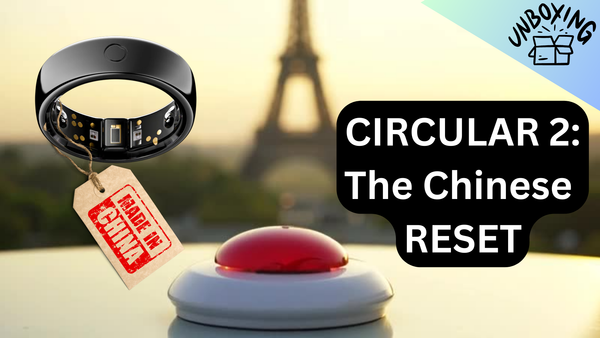Ultrahuman Sprint '25 – A Solid Load of New Features for Your Smart Ring 💍
During its Summer Release Sprint '25, Ultrahuman unveiled a range of new features, improvements, and products within its wearable ecosystem. According to the official blog, it was a week of intense cross-team collaboration focused on “redefining what’s possible.” So—did they manage to redefine it?
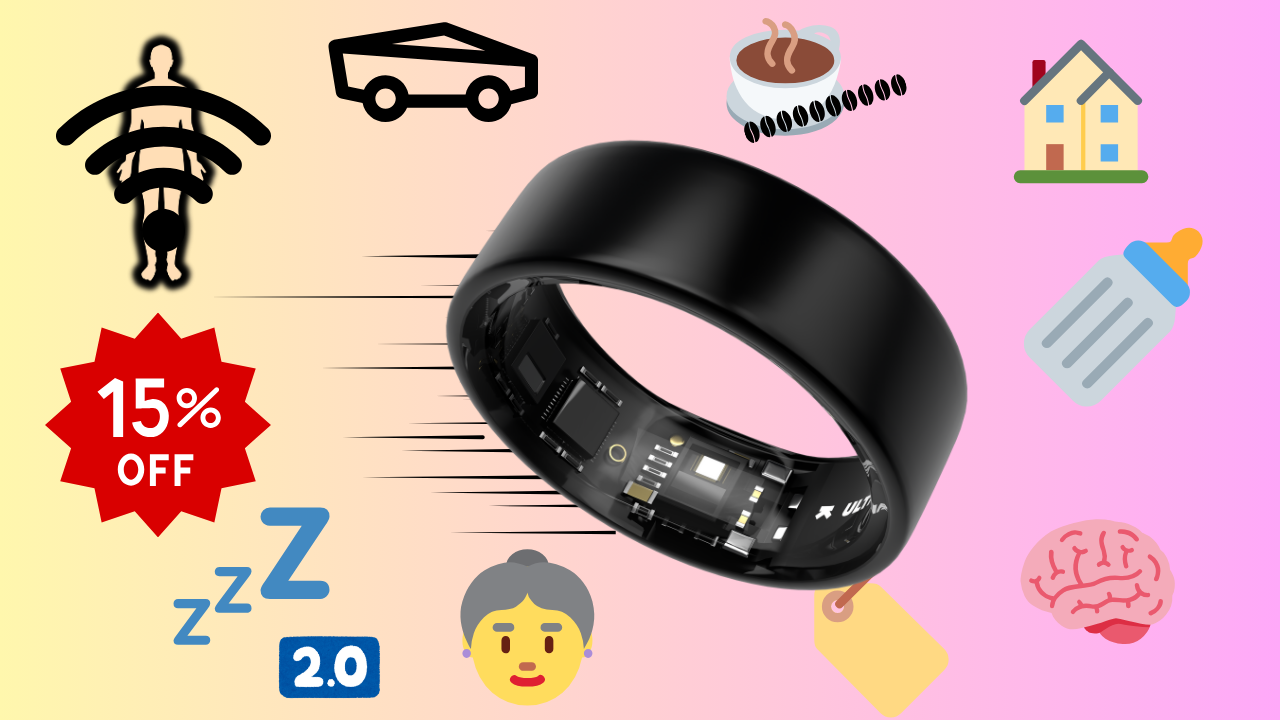
A smart ring app with no subscription and no real innovation?
That used to be the case. But then—almost like magic—a few clever minds came together. And, surprise surprise, they were in India, the global tech powerhouse.
(Okay, maybe they just met online—but still.) The result? Ultrahuman launched a wave of new features in no time.
Video version of the article
In this article, we’ll take a closer look at all the new features. They include:
- 📶 Body Signal
- 🏠 Ultrahuman Home
- 🏷️ Smart Tags
- 🍼 New Parent PowerPlug
- 🧠 Brain Waste Clearance
- 👵 Ultra Age
- 💤 Sleep Algorithm 2.0
- 🚗 UltraSync with Tesla
- ☕ Caffeine Window upgrade
- Final conclusion
📶 Body Signal
Into trends? Then you’ll enjoy Body Signal. This feature dives deeper into long-term data, tracking positive changes and progress streaks. It’s not entirely new, but it now comes with revamped visualizations of trends, milestones, and personal bests.
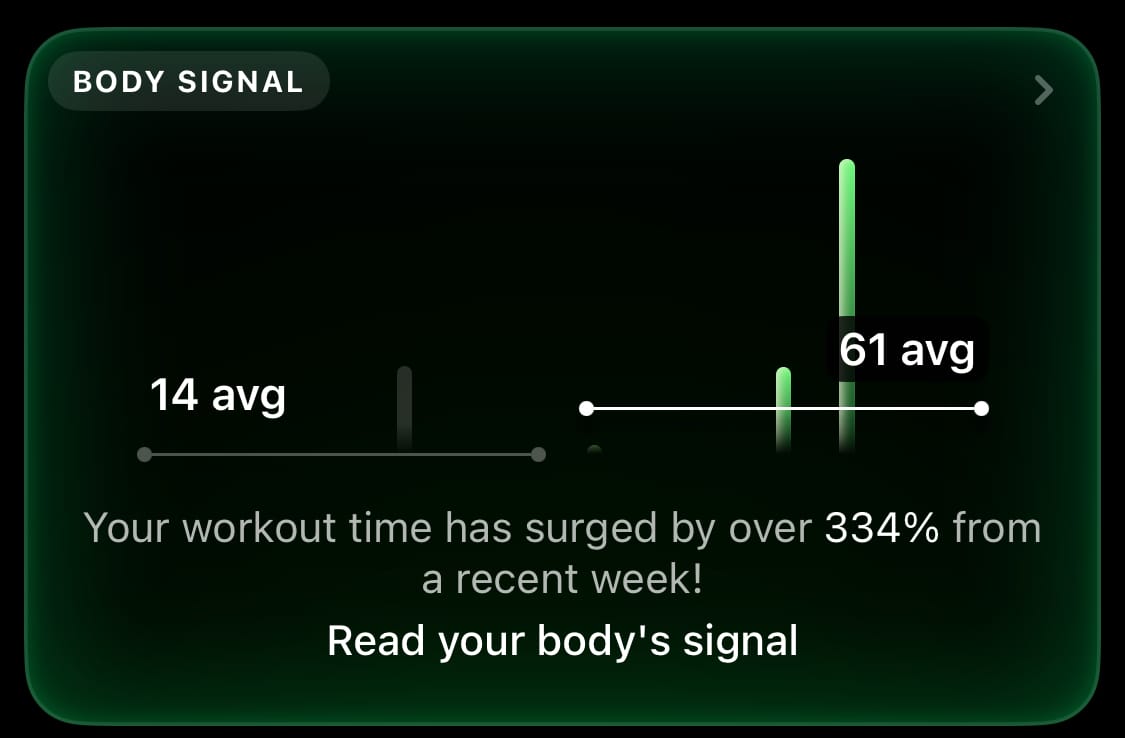
The Body Signal algorithm isn’t as strict as Duolingo. If you miss a goal for a day—say, not hitting your sleep target—it still gives you a pat on the back if it’s within acceptable limits.
| Advantages | Drawbacks / Criticism |
|---|---|
| ✔️ Long-term tracking of health trends over time (HRV, sleep, recovery) | ❌ Appears somewhat "randomly" |
| ✔️ Motivating concept of “Streaks” and “Milestones” that don’t require 100% consistency | ❌ Occasional bugs – e.g., showing “31 days out of 30”; Ultrahuman is still ironing this out |
| ✔️ Personal Best badges for hitting records | ❌ Users were confused about where to find the feature – it’s not clearly visible without prior data |
| ✔️ Ability to share progress and achievements (communication dimension) | ❌ Some users see it more as gamification than a serious tracking tool |
| ✔️ Visually clean and intuitive interface | ❌ May lack depth for analytically oriented users – focuses on overview, not deep analysis |
| ✔️ Reduces frustration over occasional setbacks – emphasizes long-term trends |
🏇 Competitors?
Oura looks for so-called patterns within its Trends section. RingConn, on the other hand, focuses on negative deviations through its Abnormality Detection feature.
🏠 Ultrahuman Home
Ultrahuman Home is a new hardware addition—a compact sensor unit designed for continuous monitoring of your home environment. The device tracks air quality (e.g., CO₂ levels, chemicals, dust), light intensity and spectrum, ambient noise, temperature, and humidity.
Why is the Home device interesting in the context of a smart ring? Because it runs within the same app and looks for correlations across data streams. More info:
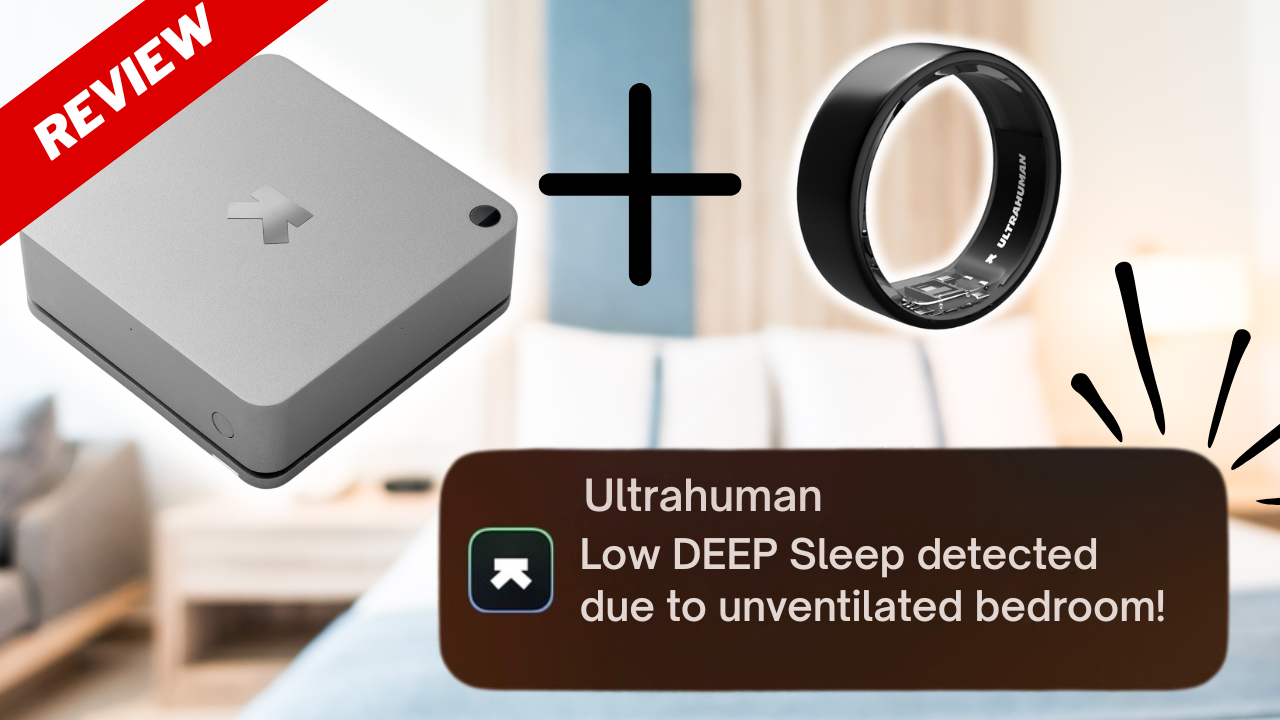
| Advantages | Drawbacks / Criticism |
|---|---|
| ✔️ Wide range of sensors in one device (CO₂, VOC, light, noise, temperature, humidity) | ❌ High price ($549) – without automation or direct actions, it feels like an expensive diagnostic tool |
| ✔️ Clear visualization of environmental data in the mobile app | ❌ No smart home integration yet (e.g., auto-starting an air purifier) |
| ✔️ Ability to track environmental impact on recovery and sleep via UltraSync™ | ❌ UltraSync connection with the ring isn’t fully functional yet (pending summer 2025 update) |
| ✔️ No subscription required – data is accessible without additional payments | ❌ Doesn’t solve problems, only diagnoses them (e.g., measures air quality but doesn’t improve it) |
| ✔️ Stylish and compact design suitable for home environments | ❌ Some users expected a loyalty discount for ring owners – none offered so far |
| ✔️ New measurement dimension within wearable ecosystem – environmental biohacking | ❌ Limited practical value without full data integration with the ring |
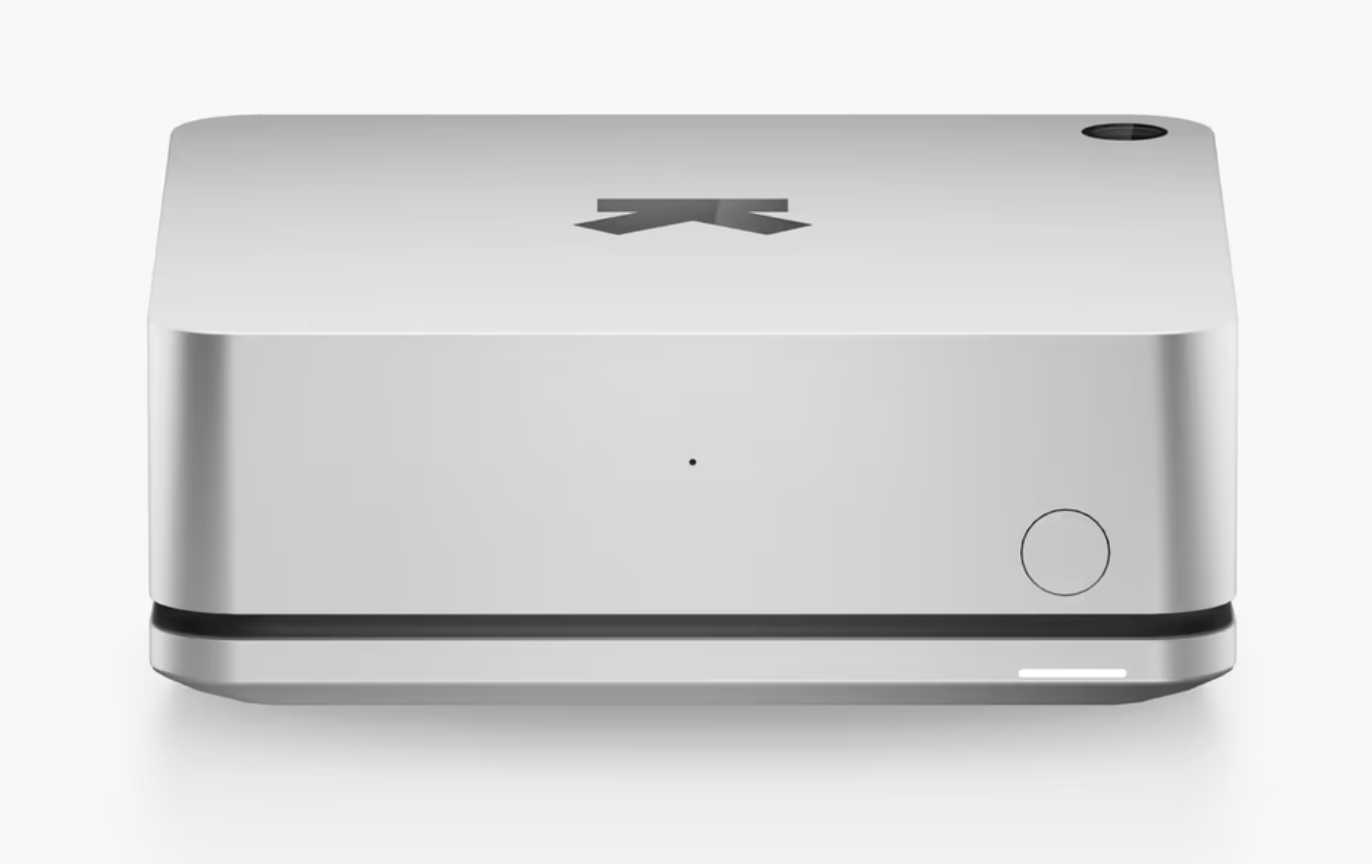
Ultrahuman Home
Smart home monitoring within the Ultrahuman ecosystem for $549.
Without UltraSync and broader connectivity, I have to knock off one star.
By using my referral link, you’ll be supporting the operation of this site 🙏
🏇 Competitors?
Ultrahuman Home is a unique creation by Ultrahuman. Competing platforms currently offer nothing comparable.
🏷️ Smart Tags
Smart Tags are a long-awaited feature that users have been asking for. They serve as a user input method to add context to measured data.
The key points:
- Tags are sometimes suggested automatically
- Users can select tags from a predefined list
- Custom tags can be created
- Tags can be timestamped
| Advantages | Drawbacks / Criticism |
|---|---|
| ✔️ Ability to add context to biometric data (e.g., illness, exercise, late meals) | ❌ Some users didn’t see the feature right away – rollout is gradual |
| ✔️ Supports both automatic and manual tags (quick entry and custom text) | ❌ Deeper analytics missing – correlations between tags and metrics are not yet fully developed |
| ✔️ User-friendly selection from predefined categories + option for custom input | ❌ Exporting tags to external tools (e.g., Ultrahuman Vision) is not yet confirmed |
| ✔️ Clear tag display in the context of sleep, recovery, etc. |
🏇 Competitors?
With this feature, Ultrahuman has nearly caught up with Oura, which developed its tagging system over several iterations. Oura currently leads in visualizing tags within its Trends section.
RingConn allows users to add notes in the app, but further interaction with them is limited. The Whoop wristband takes a more structured approach with its Journaling feature, which is highly developed but also comes with its own limitations.
🍼 New Parent PowerPlug
The parent mode is actually a very thoughtful addition. At least two types of users often complain about the standard one-size-fits-all wearable algorithms: shift workers (who Ultrahuman also considers, by the way) and parents of young children. Despite their best efforts, these groups often receive overly harsh "report cards" in the form of readiness scores and automated recommendations.

This PowerPlug (an optional extension—more on that here) is free and offers the following adjustments:
🧊
- It reduces the weight of sleep metrics (like deep sleep, efficiency), which improves the overall sleep score.
- It lowers step goals and eases workout targets.
- It emphasizes Mindful Minutes, NSDR (Non-Sleep Deep Rest), and naps.
This feature was very well received by mothers—it encourages new parents rather than adding insult to injury with messages like “you slept poorly, and your wearable confirms it."

I personally activated the Parent PowerPlug, but since I’m not the one getting up at night to tend to the baby, I’ve deactivated it again and left it on just for the mom.
| Advantages | Drawbacks / Criticism |
|---|---|
| ✔️ Addresses the real needs of new parents dealing with fragmented sleep | ❌ Exact algorithm is not publicly known – unclear how the score is recalculated |
| ✔️ Adjusts sleep and recovery assessments – more forgiving of night awakenings and short sleep | |
| ✔️ Helps boost motivation – rewards even “small wins” during a challenging life stage | |
| ✔️ Very positive user feedback – the community has been requesting such a feature for a long time |
🏇 Competitors?
No competing platform offers anything similar, which has caused some frustration—especially among mothers. Personally, I see this as a deliberate and welcome disruption of the “one-size-fits-all” algorithm, tailored to a specific group of users.
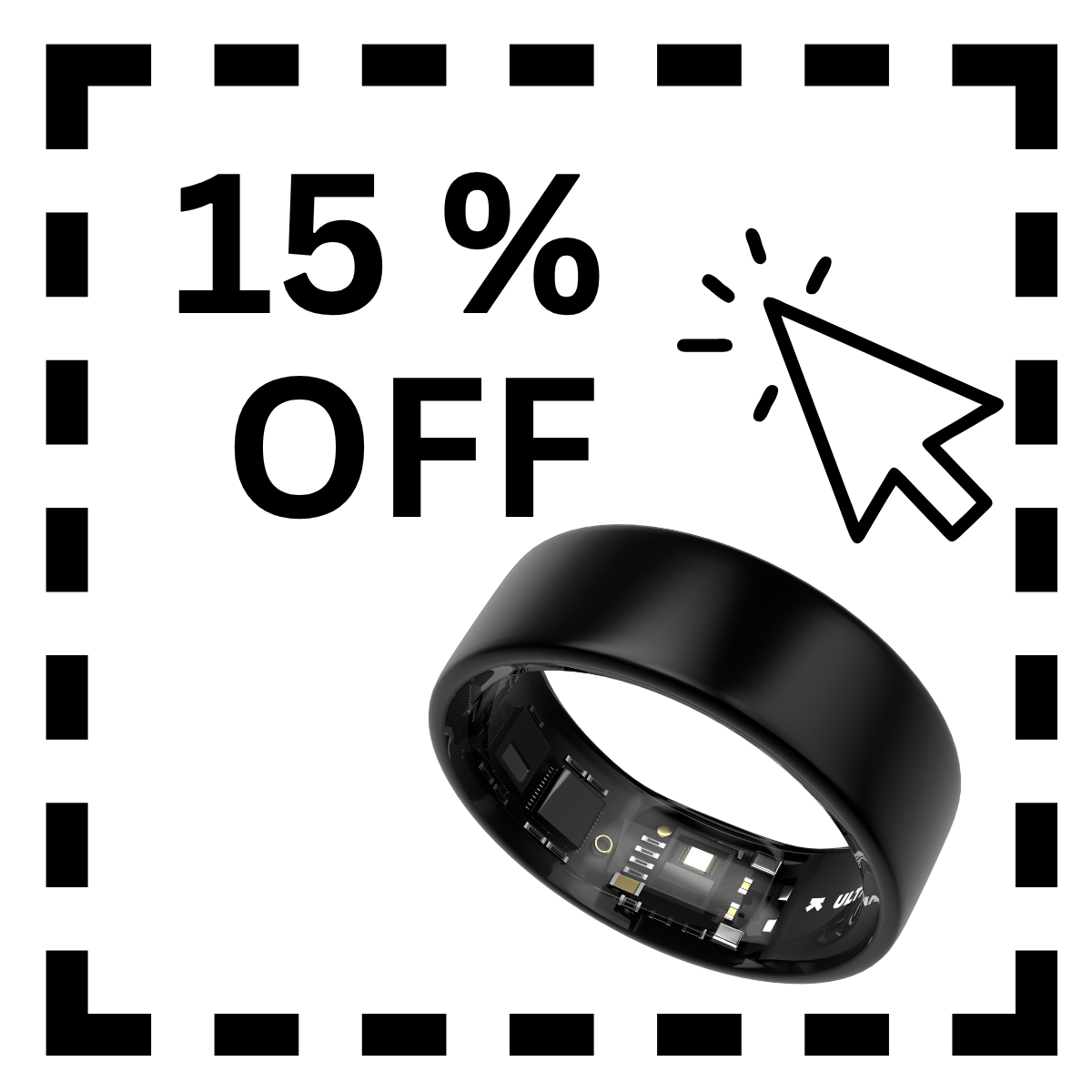
Ultrahuman AIR
Most comprehensive smart ring. No subscription. Discount ends June 30, 2025. Affiliate link – supports my work.
🧠 Brain Waste Clearance
The "brain cleansing" indicator is arguably the most scientifically ambitious addition of this sprint. It’s a new metric meant to estimate how effectively your brain has cleared metabolic waste during sleep.
No, your smart ring can’t measure toxins in your brain—but it tries to infer them through data from your finger. My first reaction was critical: this seems to push the limits of what can realistically be derived from optical sensors on a ring. And I still consider it more of a gimmick—a marketing-friendly feature that should be taken with a grain of salt.
That said, I appreciate the out-of-the-box thinking and the creativity Ultrahuman is bringing to the table. Plus, it's a metric that highlights the importance of quality sleep.
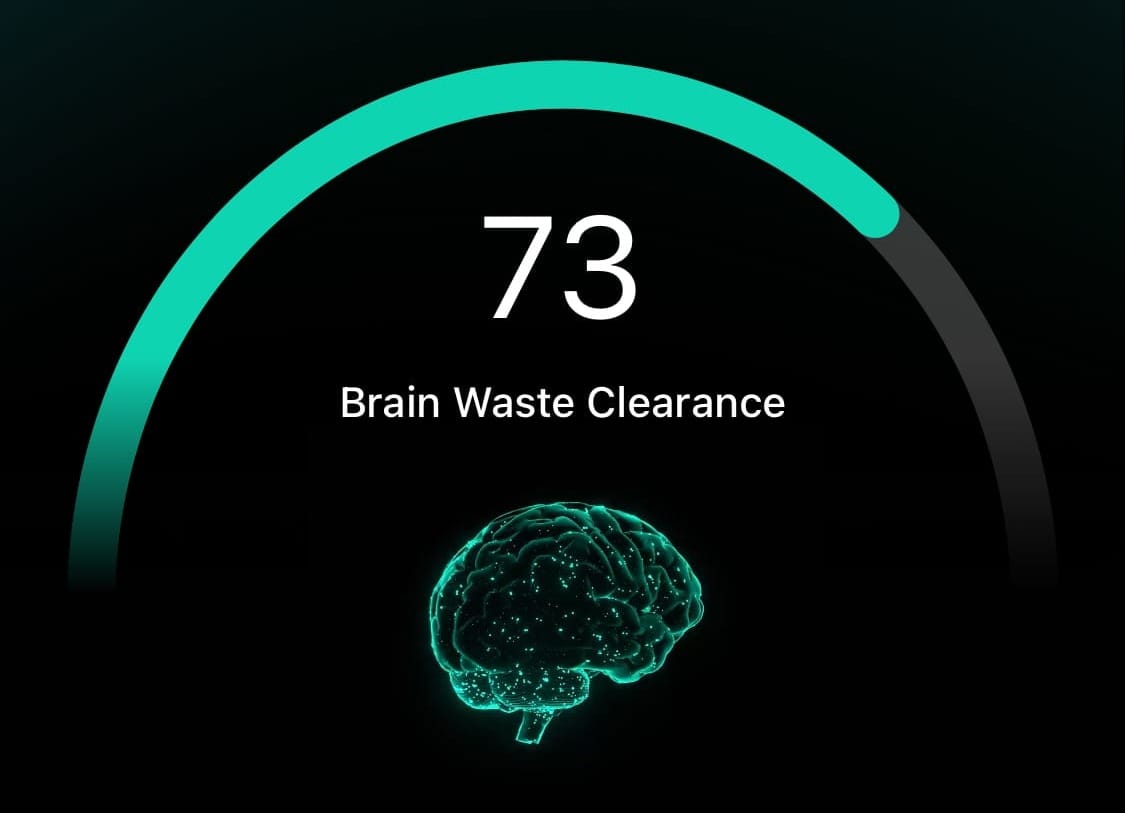
The metric is represented as a 0–100 score and is based on the following contributors: deep sleep, total sleep duration, sleep efficiency score, HRV, sleep debt penalty, and temperature.
| Advantages | Drawbacks / Criticism |
|---|---|
| ✔️ Ambitious attempt to estimate the efficiency of the glymphatic system (brain cleansing during sleep) | ❌ Cannot be measured directly – BWC is an estimate based on indirect data (HRV, sleep, temperature) |
| ✔️ Offers a new neuroscientific perspective on sleep quality | ❌ Community questions its validity – concerns about it being a “pseudo-scientific gimmick” |
| ✔️ Raises awareness of sleep’s impact on cognitive health | ❌ May cause unnecessary anxiety – e.g., red score without clear guidance on what to do |
| ✔️ Enables long-term trend tracking – ideally motivates better sleep hygiene | ❌ Unclear how well the BWC score correlates with reality – lacks clinical validation |
| ✔️ Unique metric – no other wearable platform currently offers a similar marker |
🏇 Competitors?
No competing platform currently offers anything similar.
👵 Ultra Age
Ultra Age is a new metric designed to reflect how old your body is—and how fast it’s aging—compared to your chronological age. It’s a combination of three components:
- Brain Age – derived from:
- Sleep index over the past 7 days
- Overall sleep score
- Deep sleep score
- HRV evaluation
- Sleep debt over the past week
- Temperature score
- Pulse Age – derived from:
- Arterial flexibility
- Blood flow speed
- Smoothness of blood flow
- Heart rate quality
- Heart rate stability
- Blood Age – included in the calculation only if the user has taken Blood Vision lab tests.
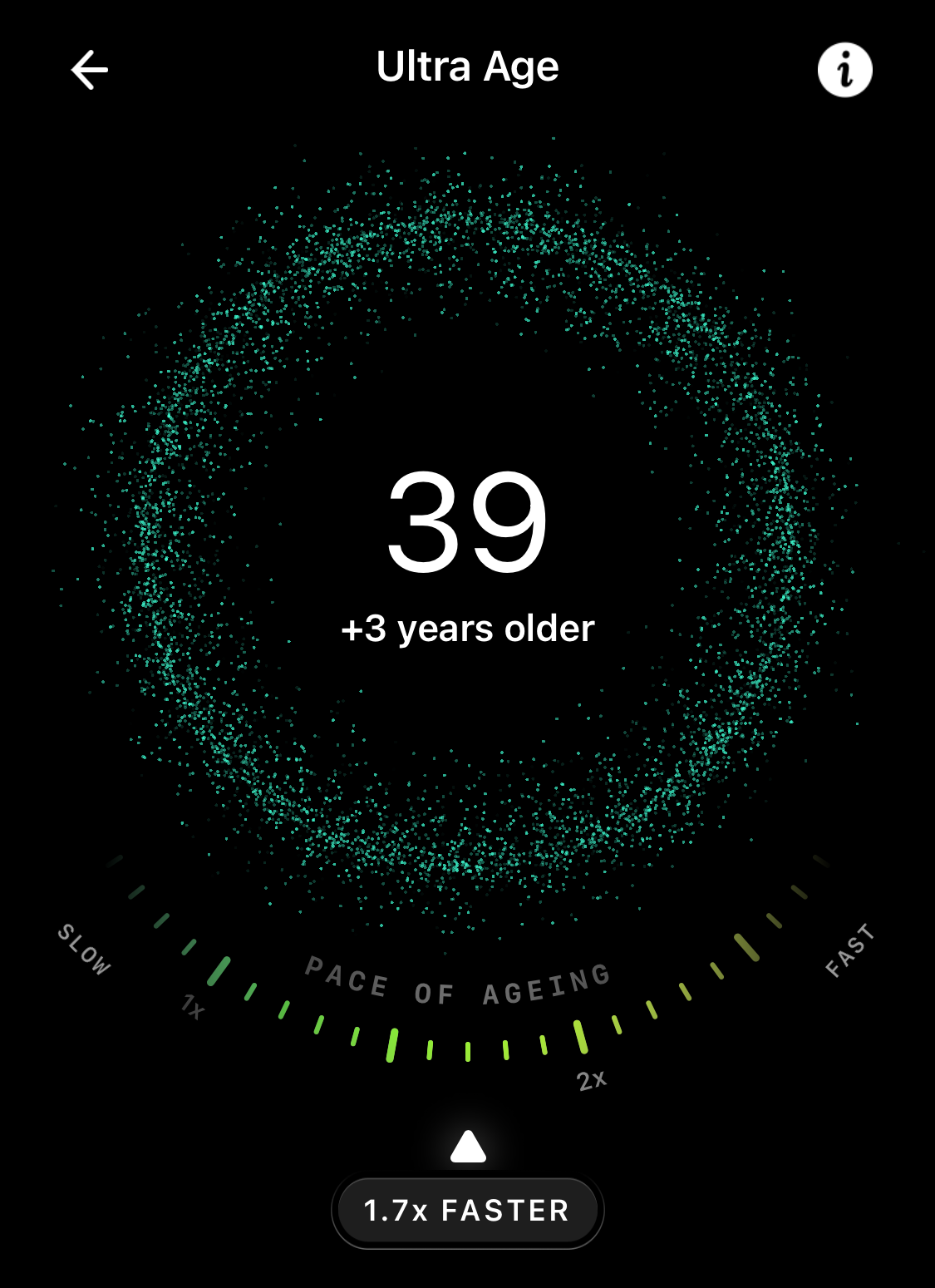
| Advantages | Drawbacks / Criticism |
|---|---|
| ✔️ Accounts for biological age – including components like Brain Age, Pulse Age, and (optionally) Blood Age | ❌ Some components (e.g., Pulse Age) only appear after weeks of data; Blood Age requires a paid blood test |
| ✔️ Includes “Pace of Aging” – tracks whether your body is aging faster or slower than it should | ❌ Absolute numbers can be misleading – users might focus more on numbers than on trends |
| ✔️ Motivating feedback – reinforces prevention and lifestyle awareness | ❌ Clearly inspired by similar features on competing platforms (e.g., Whoop Health Span) |
| ✔️ Visually appealing widget on the main dashboard | ❌ One more element on an already crowded Ring home screen |
| ✔️ Enables conscious improvement of specific components (e.g., brain, heart, blood markers) |
🏇 Competitors?
Biological age, functional age, Whoop age, heart health... Competing platforms throw these terms around quite a bit. They're hard to compare across platforms since they’re all based on more or less sophisticated algorithms.
Still, Ultrahuman is catching up with Oura and its Cardiovascular Age, which also estimates arterial quality—and indirectly, age—via PWV (Pulse Wave Velocity). Whoop also deserves mention here, as it clearly inspired Ultrahuman, both visually and with its inclusion of a Pace of Aging metric.
For the record: Ultra Age feels ultra-harsh to me. Apparently, I’m older and aging faster than what other wearables say.
💤 Sleep Algorithm 2.0
The improved sleep algorithm is a very welcome update, as sleep—and sleep-related metrics—feed into a wide range of other derived data points.
The quality of sleep algorithm comparisons has even been the subject of a dedicated test, in which Ultrahuman took part.
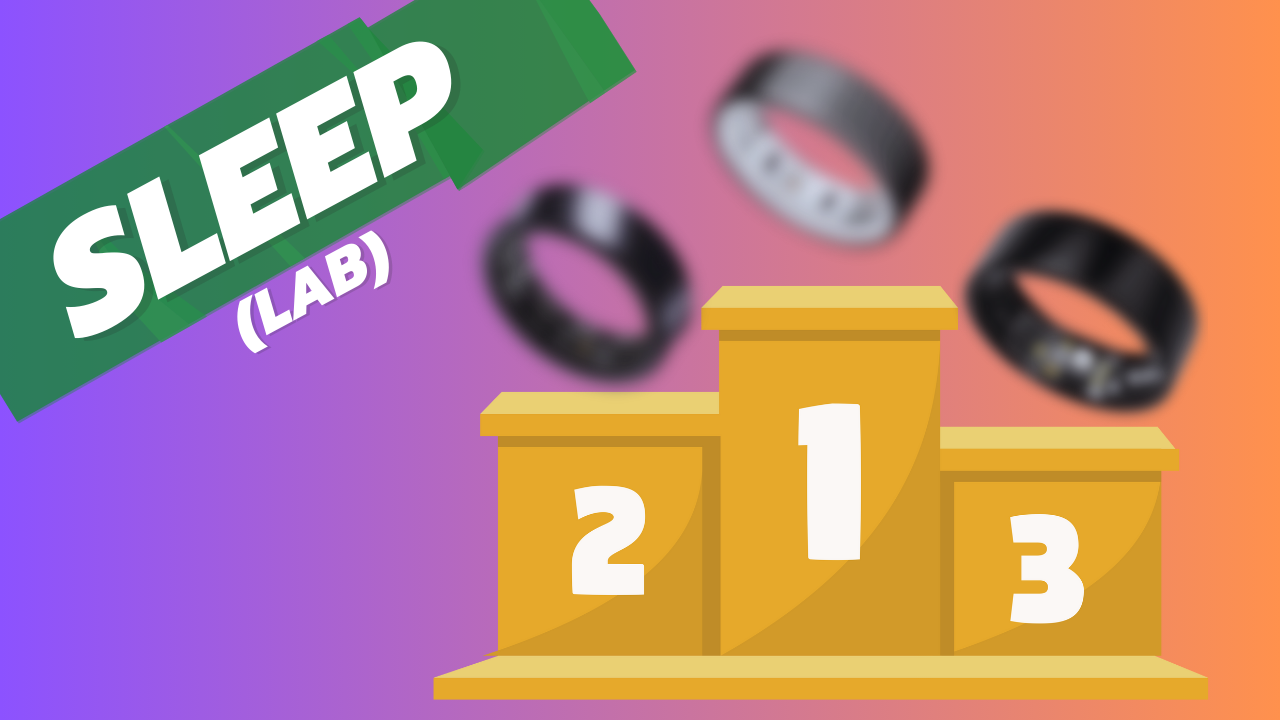
Ultrahuman claims that its updated sleep stage calculations now factor in individual characteristics and patterns based on a user’s gender, age, and BMI. Additionally, the new algorithm model has been trained on more than 125,000 nights of sleep data.
| Advantages | Drawbacks / Criticism |
|---|---|
| ✔️ Improved model trained on 125,000+ nights of data | ❌ No visible change for most users – the update is “under the hood” |
| ✔️ Takes individual factors into account (age, gender, BMI) – more personalized | ❌ Some users reported unusually low deep sleep values after the update |
🏇 Competitors?
Sleep algorithms in smart rings and other wearables are continuously refined. A notable example is Oura’s past upgrade to its sleep algorithm:
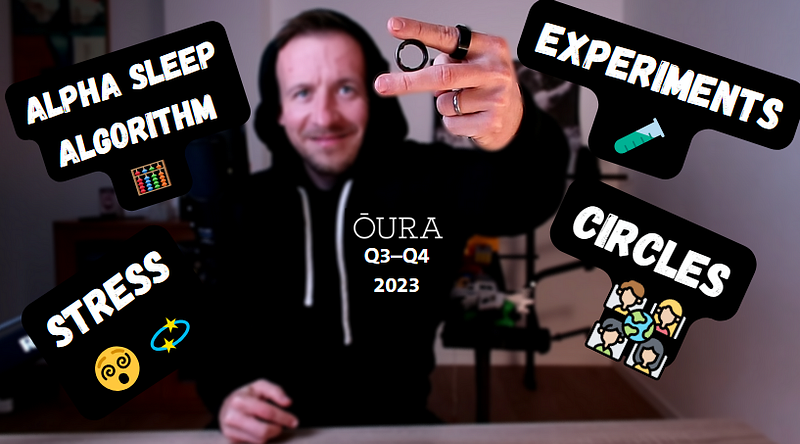
🚗 UltraSync with Tesla
UltraSync with Tesla is arguably the oddest feature of the entire sprint. If it had launched on April 1st, I wouldn’t have been surprised.
It links the Ultrahuman ring with a Tesla vehicle and displays a Drive Readiness Score based on your sleep and fatigue levels. It also tracks stress during drives and maps it out geographically.
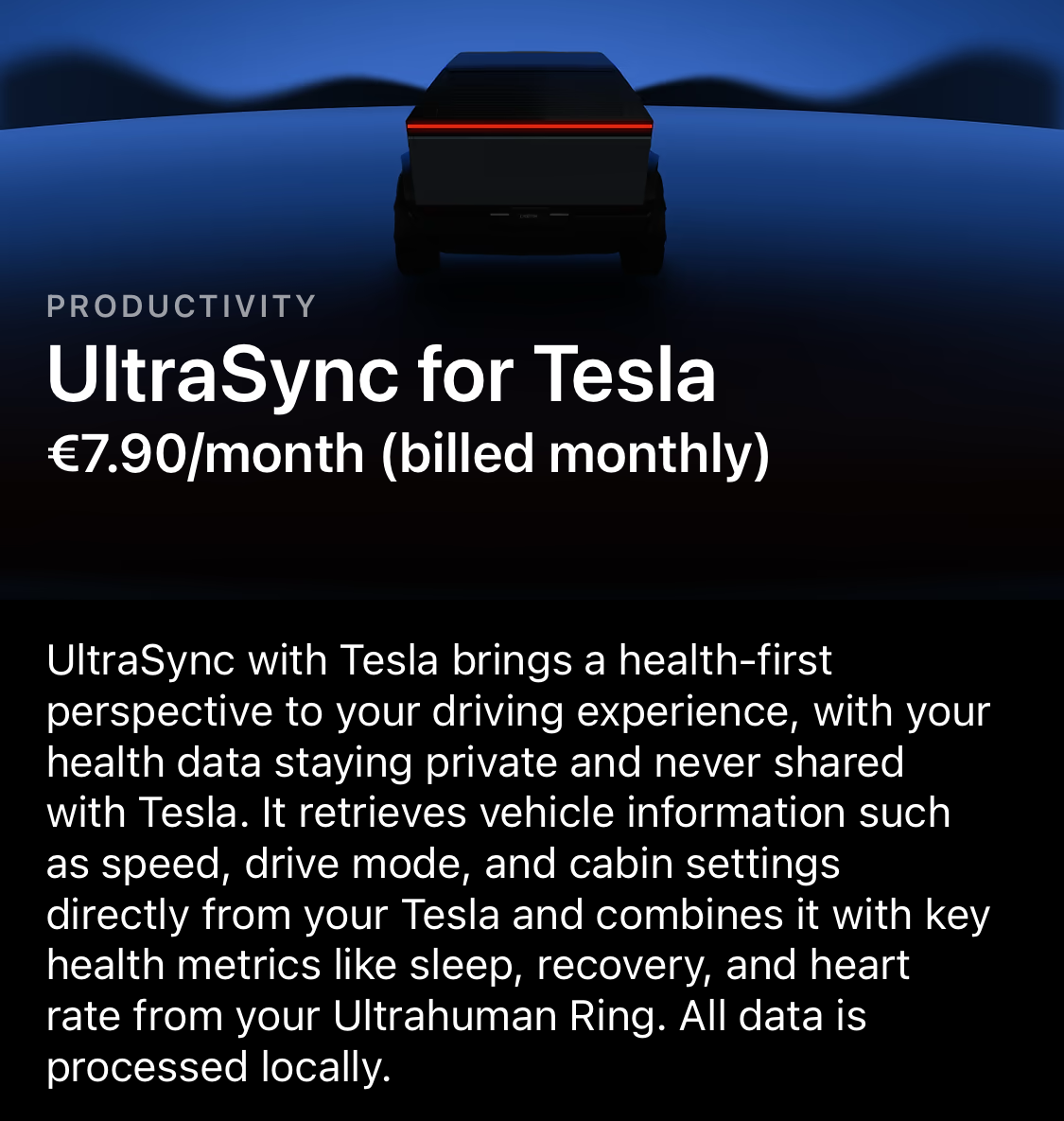
I don’t own a Tesla, so it’s hard for me to judge this firsthand. The community tends to see it more as a marketing novelty than a truly useful feature.
| Advantages | Drawbacks / Criticism |
|---|---|
| ✔️ Drive Readiness Score – links fatigue, sleep, and driving readiness | ❌ Useful only for a small percentage of users who own a Tesla |
| ✔️ Tracks and maps driving segments with elevated stress | ❌ Community criticism: “flashy PR stunt” rather than a broadly useful feature |
| ✔️ Interesting (?) crossover of biometrics into road safety | ❌ No official partnership with Tesla – relies on public APIs |
| ✔️ Merges body and car data – a new angle for behavioral analysis | ❌ Premium feature – available only via paid PowerPlug |
🏇 Competitors?
Nope.
☕ Caffeine Window Upgrade
Surprisingly, the caffeine window has become one of Ultrahuman’s most popular PowerPlugs. Until now, it was a pretty basic visual of how caffeine clears from the system, based solely on a fixed “wake-up time + 90 minutes” rule.
Now it finally works the way I always imagined: you can log your caffeine drinks, and the caffeine curve updates visually and dynamically, giving you an approximate idea of how much caffeine is in your system at any given moment.
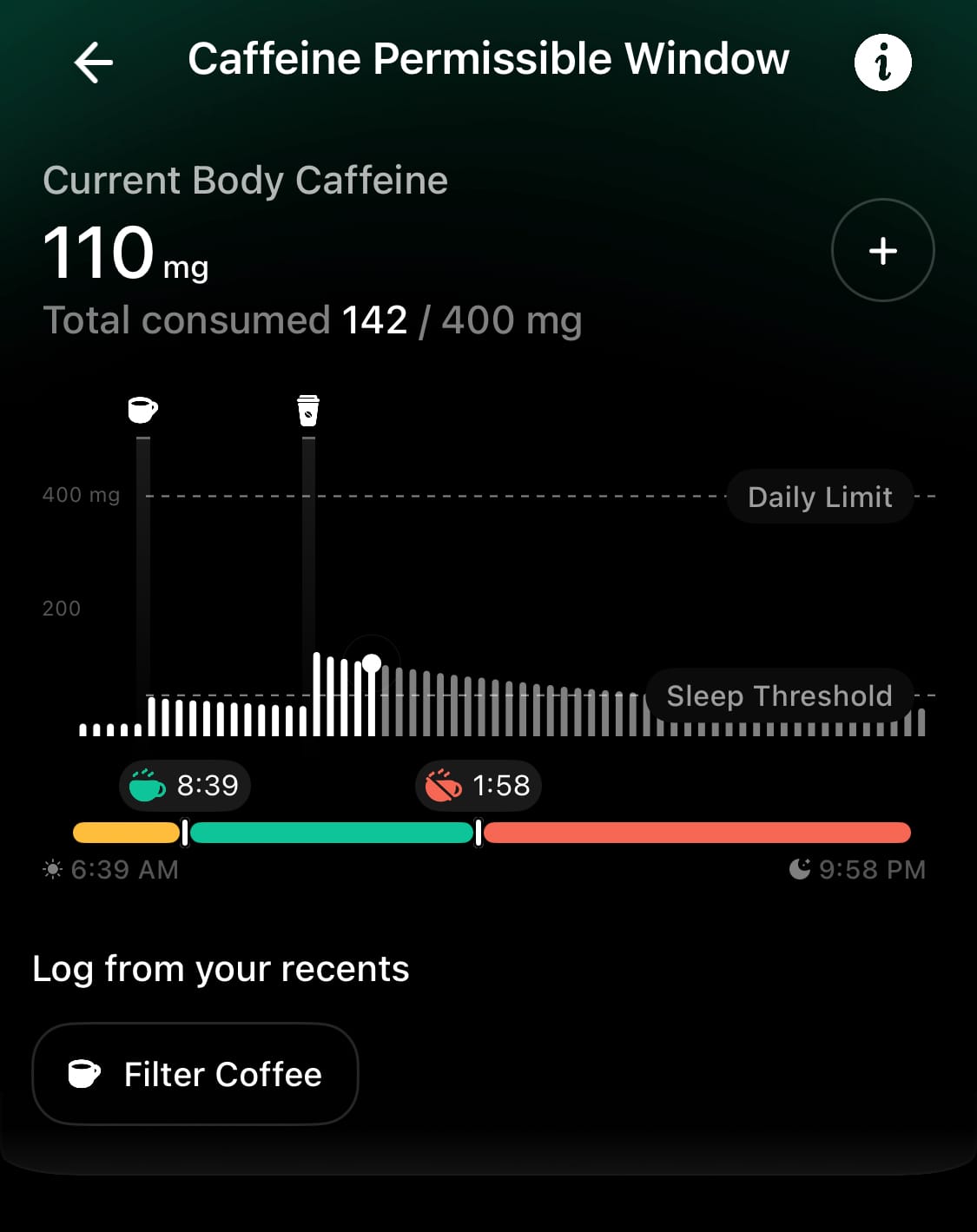
| Advantages | Drawbacks / Criticism |
|---|---|
| ✔️ Real-time tracking of caffeine levels in the body | ❌ Doesn’t account for shift work or alternative circadian rhythms – not ideal for night shift users |
| ✔️ Dynamic recommendations for last coffee time based on recovery/sleep | ❌ The post-wake delay (“wait 90 minutes before first coffee”) sparked debates about its scientific validity |
| ✔️ “Caffeine Bonus” for quality sleep – more flexibility on well-rested days | ❌ No option to disable or customize certain recommendations (e.g., the above-mentioned morning delay) |
| ✔️ Easy drink logging via Caffeine Bar database and pinned favorite drinks | ❌ Some drinks are missing from the database, and there’s no way to add your own |
🏇 Competitors?
There is coffee experiment in Oura Platform. Nothing more.
🔚 Conclusion
In recent months, Ultrahuman has set a remarkably fast—arguably unique—pace in the development of its app.
Not all features turned out equally well. Some, like Smart Tags or the revamped Body Signal, are clear improvements. Others—such as the Tesla integration or “brain waste clearance”—feel more like PR experiments or overly ambitious out-of-the-box thinking.
If I had to rank the new features by their usefulness, the list would look like this:
| 🏷️ Feature | 📈 Expected Impact | 💬 Reason for Ranking |
|---|---|---|
| Smart Tags | High | Low complexity, high value – finally adds context to data. In demand, easy to understand, well received. |
| Body Signal | High | Encourages long-term health tracking. Clear system, appreciated by the community. |
| Caffeine Window upgrade | Medium to High | Real impact on sleep, simple to use. Needs refinement for shift work and controversial recommendations. |
| Sleep Algorithm 2.0 | Medium to High | Better accuracy, but hard to notice. Foundational, but poorly communicated. |
| New Parent PowerPlug | Medium | A big help for a niche audience—new parents. Valuable but narrowly focused. |
| Ultra Age | Medium | Ambitious and interesting concept, but partly locked behind blood tests and sometimes confusing. |
| Ultrahuman Home | Low to Medium | Interesting hardware, but no automation yet. Feels like an expensive diagnostic tool for most people. |
| Brain Waste Clearance | Low | Innovative but lacks credibility. No validation, risk of unnecessary stress. |
| UltraSync with Tesla | Very Low | Flashy but not effective – most users don’t have a Tesla. Seen as a PR feature. |
When I look at where Ultrahuman’s developers chose to invest their energy—like syncing with Teslas—I can’t help but wonder:
- Where’s the respiration rate? A key metric for detecting illness, for example.
- Where’s a meaningful update to the Metabolism tab? With the Oura Ring, you can already take photos of your meals and have them analyzed by AI. With Ultrahuman, you’re still manually typing in “chicken butter”...
- Why are defective ring reports still popping up on community forums? (Thankfully, not my case.)
So, what’s the final verdict?
If you enjoy exploring your body, spotting patterns, and experimenting with new metrics, Ultrahuman is becoming an increasingly compelling option.
And most importantly: it’s no longer just “a subscription-free ring.” It’s a platform that dares to think for itself—and occasionally, dares to do something entirely new.
- 👉 Shop with 15 % OFF: https://lotsr.link/ultrahuman (limited offer)
- 💍 Ultrahuman AIR AMAZON DISCOUNT CODE – 10% OFF with code "AMZNFITNS10"
- 👉 Shop now https://lotsr.link/uh-amazon




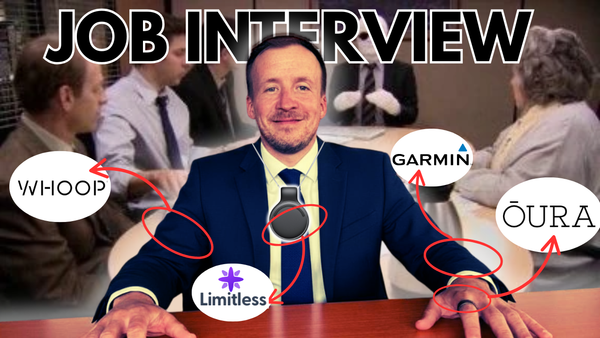
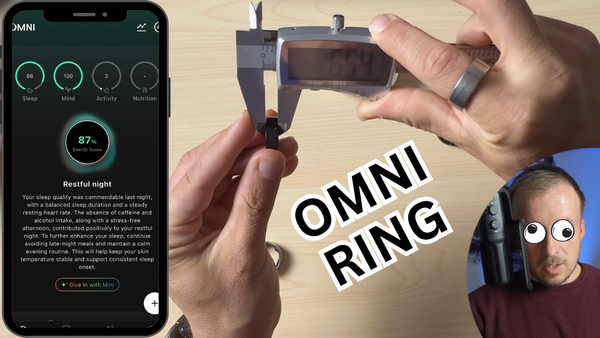
![Whoop 5 / MG – is it worth the money? [Review]](/content/images/size/w600/2025/10/WHOOP-MG-review.png)
